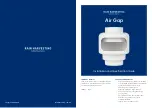
4
understand and follow all instructions provided with the
accessory or attachment.
28. Data indicates that operators, age 60 years and above,
are involved in a large percentage of tractor-related
injuries. These operators should evaluate their ability to
operate the tractor safely enough to protect themselves
and others from serious injury.
29. If situations occur which are not covered in this manual,
use care and good judgment. Contact your Cub Cadet
dealer for assistance.
Slope Operation
Slopes are a major factor related to loss of control and tip-over
accidents which can result in severe injury or death. All slopes
require extra caution. If you cannot back up the slope or if you
feel uneasy, do not mow it.
For your safety, use the slope gauge included as part of this
manual to measure slopes before operating this unit on a
sloped or hilly area. If the slope is greater than 15 degrees as
shown on the slope gauge, do not operate this unit on that
area.
Do:
1.
Mow across slopes, not up and down. Exercise extreme
caution when changing direction on slopes.
2.
Watch for holes, ruts, bumps, rocks, or other hidden
objects. Uneven terrain could overturn the machine. Tall
grass can hide obstacles.
3.
Use slow speed. Choose a low enough speed setting so
that you will not have to stop mowing while on the slope.
Tires may lose traction on slopes.
4.
Follow the manufacturer’s recommendations for wheel
weights or counterweights to improve stability of the
machine. Use extra care with grass catchers or other
attachments. These can change stability of the machine.
5.
Keep all movement on the slopes slow and gradual. Do
not make sudden changes in speed or direction. Rapid
engagement or braking could cause the front of the
machine to lift and rapidly flip over backwards which could
cause serious injury.
6.
Avoid starting or stopping on a slope. If tires lose traction,
disengage the blade(s) and proceed slowly off of the
slope.
Do Not:
1.
Do not turn on slopes unless necessary; then, turn slowly
and gradually uphill, if possible.
2.
Do not mow near drop-offs, ditches or embankments. The
mower could suddenly turn over if a wheel is over the
edge of a cliff, ditch, or if an edge caves in.
3.
Do not try to stabilize the machine by putting your foot on
the ground.
4.
Do not use a grass catcher on steep slopes.
5.
Do not mow on wet grass. Reduced traction could cause
sliding.
6.
Do not tow heavy pull behind attachments (e.g. loaded
dump cart, lawn roller, etc.) on slopes greater than 5
degrees. When going down hill, the extra weight tends to
push the machine and may cause you to lose control. (e.g.
tractor may speed up, braking and steering ability are
reduced, attachment may jack-knife and cause machine
to overturn).
Children
1.
Tragic accidents can occur if the operator is not alert to
the presence of children. Children are often attracted to
the machine and the mowing activity. They do not
understand the dangers. Never assume that children will
remain where you last saw them.
a.
Keep children out of the mowing area and in
watchful care of a responsible adult other than the
operator.
b.
Be alert and turn machine off if a child enters the
area.
c.
Before and while backing, look behind and down
for small children.
d.
Never carry children, even with the blade(s) shut
off. They may fall off and be seriously injured or
interfere with safe machine operation.
e.
Use extreme care when approaching blind corners,
doorways, shrubs, trees or other objects that may
block your vision of a child who may run into the
machine.
f.
Disengage the cutting blade(s) before moving in
reverse.
g.
Keep children away from hot or running engines.
They can suffer burns from a hot muffler.
h.
Remove key when machine is unattended to
prevent unauthorized operation.
2.
Never allow children under 14 years old to operate
the machine. Children 14 years old and over should
read and understand the operation instructions and
safety rules in this manual and should be trained
and supervised by a parent.
Towing
1.
Tow only with a machine that has a hitch designed for
towing. Do not attach towed equipment except at the hitch
point.
2.
Follow the manufacturers recommendation for weight
limits for towed equipment and towing on slopes.
3.
Never allow children or others in or on towed equipment.
4.
On slopes, the weight of the towed equipment may cause
loss of traction and loss of control.
5.
Travel slowly and allow extra distance to stop.
Service
Safe Handling Of Gasoline
1.
To avoid personal injury or property damage use extreme
care in handling gasoline. Gasoline is extremely
flammable and the vapors are explosive
.
Serious personal
injury can occur when gasoline is spilled on yourself or
your clothes which can ignite. Wash your skin and change
clothes immediately.
a.
Use only an approved gasoline container.
b.
Never fill containers inside a vehicle or on a truck
or trailer bed with a plastic liner. Always place
containers on the ground away from your vehicle
before filling.
c.
When practical, remove gas-powered equipment
from the truck or trailer and refuel it on the ground.
If this is not possible, then refuel such equipment
on a trailer with a portable container, rather than
from a gasoline dispenser nozzle.
d.
Keep the nozzle in contact with the rim of the fuel
tank or container opening at all times until fueling is


































